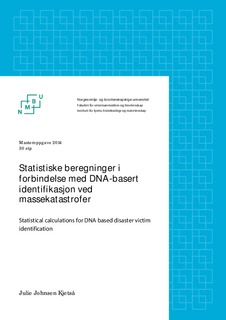| dc.description.abstract | Disaster victim identification is a part of family genetics in forensic science, and to identify missing persons by kinship analysis, DNA evidence is used. Identification of missing persons can be performed either by a direct match with reference samples from personal items, or, as in this thesis, based on calculation of kinship between the missing person and assumed reference relatives. Siblings share between zero and two alleles IBD, while a parent and child will share one, apart from mutations. In the calculations, this and allele frequencies in the population is used. To indicate kinship, the hypothesis that the missing person is related to the reference members is compared to the hypothesis stating that the missing person is unrelated to the known reference members, and the results are presented as a likelihood ratio.
This thesis examined how different scenarios will affect the identification of missing persons by use of reference relatives. The accuracy of the identification has been studied by having a different number of reference relatives and genetic markers, and is done to be able to say what is appropriate so that the identification will be informative. To calculate the probabilities of the data given a hypothesis, the program Familias is used. For each scenario, simulated data for 100 missing persons and reference relatives are studied. In general, more reference relatives will result in a greater accuracy of the identification, but using too many might be unnecessary and too costly. The results of this thesis confirm that using both parents of the missing person are preferred as relatives to kinship analysis. The mean value of LR is 3.47∙106 times greater for match with parents compared to sibling when using the CODIS genetic marker system. A higher number of genetic markers will
achieve a greater mean value of LR, and in that way give a higher number of informative
identifications. | nb_NO |
